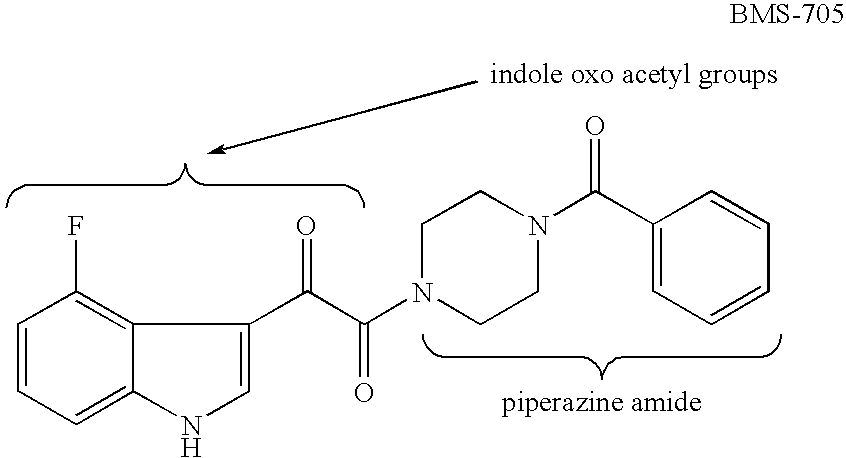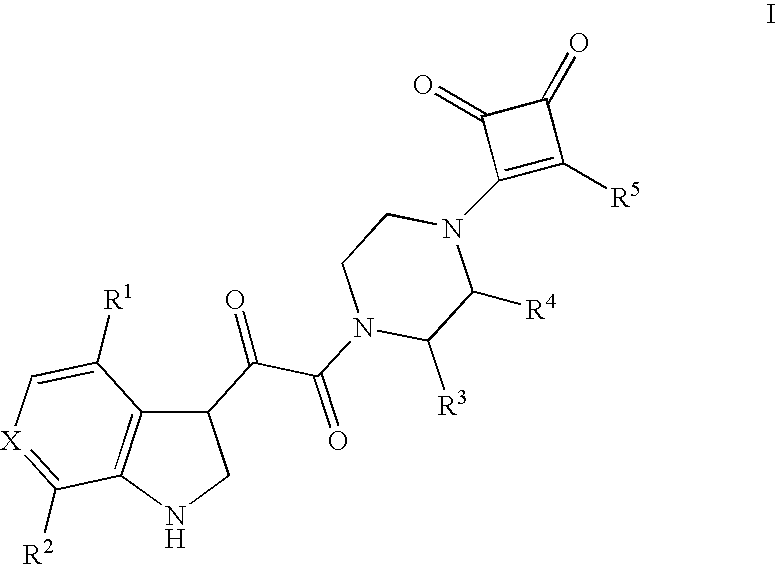4-Squarylpiperazine Derivatives as Antiviral Agents
- Summary
- Abstract
- Description
- Claims
- Application Information
AI Technical Summary
Benefits of technology
Problems solved by technology
Method used
Image
Examples
example 1
[0164]As illustrated in Scheme 1, 3-isopropoxy-4-substituted-cyclobut-3-ene-1,2-diones were conveniently used as precursors, being prepared from either 3,4-diisopropoxy-cyclobut-3-ene-1,2-dione (cf L. S. Liebeskind, et al., J. Org. Chem. 1988, 53, 2482) or from 3-isopropoxy-4-(tri-n-butylstannyl)-cyclobut-3-ene-1,2-dione (cf L. S. Liebeskind, et al., J. Org. Chem. 1993, 58, 3543) according to methods well-documented in the literature. Subsequent reaction of these precursors with piperazine or a 2-substituted-piperazine in a suitable solvent, as for example ethanol, afforded the intermediate 3-piperazinyl-4-substituted-cyclobut-3-ene-1,2-diones. Alternatively, this reaction could be done in analogous fashion using a suitably protected piperazine or 3-substituted-piperazine (using for example a BOC or similar amine protecting group well-known to one skilled in the art), with the proviso that the protecting group be removed before proceeding to the next step. In the case of a BOC group...
example 2
[0245]As illustrated in Scheme 2, a series of indole-3-(2-oxo)acetic acid derivatives were conveniently prepared by reacting an indole, as for example 4-fluoroindole, with oxalyl chloride in ether. The resulting acid chloride derivative was readily reacted with any of a series of 3-piperazinyl-4-substituted-cyclobut-3-ene-1,2-diones in the presence of a suitable amine base in an appropriate solvent, as for example diisopropylethylamine in dichloromethane, to afford the corresponding desired amide derivatives.
[0246]The compounds B1-B8 were prepared.
B1
2-(4-Fluoro-1H-indol-3-yl)-2-oxoacetyl chloride
[0247]
[0248]To a stirred solution of 4-fluoroindole (2.00 g, 14.8 mmol) in ether (15 mL), at 0° C. under Ar, was added oxalyl chloride (1.55 mL, 17.8 mmol) dropwise. The resulting suspension was stirred at room temperature for 1 h and then it was filtered and the filtercake was washed with ether. The resulting solid was dried in vacuo to give the title compound (2.60 g, 78%) as a yellow powd...
example 3
[0287]As series of aminocyclobut-3-ene-1,2-dione derivatives were prepared as exemplified in Scheme 3. Thus, reaction of a 3-isopropoxy-4-(piperazin-1-yl)-cyclobut-3-ene-1,2-dione derivative with a primary or secondary amine in an appropriate solvent, as for example ethanol at room temperature to 80° C., afforded the corresponding 3-amino-4-(piperazin-1-yl)-cyclobut-3-ene-1,2-dione derivatives.
3-[4-[2-(4-Fluoro-1H-indol-3-yl)-2-oxoacetyl]piperazin1-yl]-4-dimethylamino-cyclobut-3-ene-1,2-dione
[0288]
[0289]To a saturated solution of dimethylamine in ethanol (2 mL), cooled at 5° C. under Ar, was added 3-[4-[2-(4-fluoro-1H-indol-3-yl)-2-oxoacetyl]piperazin1-yl]-4-isopropoxy-cyclobut-3-ene-1,2-dione (0.020 g, 0.048 mmol) and the mixture was then allowed to stir at room temperature for 2 h. The volatiles were then removed in vacuo to give the essentially pure title compound (0.019 g, 99%) as a white solid:
[0290]IR (KBr) 1586 cm−1.
[0291]1HNMR (400 MHz, THF-d8) δ 11.50 (br s, 1H), 8.08 (s, 1...
PUM
| Property | Measurement | Unit |
|---|---|---|
| Electric charge | aaaaa | aaaaa |
| Antimicrobial properties | aaaaa | aaaaa |
Abstract
Description
Claims
Application Information
 Login to View More
Login to View More - R&D
- Intellectual Property
- Life Sciences
- Materials
- Tech Scout
- Unparalleled Data Quality
- Higher Quality Content
- 60% Fewer Hallucinations
Browse by: Latest US Patents, China's latest patents, Technical Efficacy Thesaurus, Application Domain, Technology Topic, Popular Technical Reports.
© 2025 PatSnap. All rights reserved.Legal|Privacy policy|Modern Slavery Act Transparency Statement|Sitemap|About US| Contact US: help@patsnap.com



